The Huawei Mate S Review
by Andrei Frumusanu on December 2, 2015 8:00 AM EST- Posted in
- Smartphones
- Huawei
- Mobile
- Kirin
- Mate S

Huawei has been a company which over the past few years has visibly increased its presence in western markets. The Chinese vendor has in particular executed a big push into European markets over the last year as devices have become increasingly available in the usual electronics shops. Following the high-key introduction of the Mate 7 last year, Huawei seems to have settled on a Samsung-like release cadence where we see the smaller P-series introduced in spring and the Mate phablet series in autumn.

This year Huawei launched the Mate S - not a direct sucessor to the Mate 7, but still clearly a device that continues the design language of the Mate lineup. First up, let's go over the specifications and see what the new hardware provides in terms of upgrades.
| Huawei Mate S | ||
| SoC | HiSilicon Kirin 935 4x Cortex A53@1.5GHz, 4x Cortex A53e@2.2GHz Mali-T628MP4 680MHz |
|
| RAM | 3GB LPDDR3 | |
| Storage | 32GB / 64GB NAND + microSD (128GB in 2016) |
|
| Display | 5.5” 1080p Samsung AMOLED Gorilla Glass 4 + Force Touch in 128GB model (2016) |
|
| Modem | 2G / 3G / 4G LTE UE Category 6 (SoC Integrated HiSilicon Balong Modem) |
|
| Networks (CRR-L09 Model) |
TDD LTE | B40 |
| FDD LTE | B1 / B2 / B3 / B4 / B5 / B7 / B8 / B12 / B17 / B18 / B19 / B20 / B25 / B26 / B28 | |
| UMTS | 850 / 900 / AWS / 1900 / 2100 ( B19 / B8 / B6 / B5 / B4 / B2 / B1) |
|
| DC-42M | B1 / B2 / B4 / B5 / B8 | |
| GSM | 850 / 900 / 1800 / 1900 | |
| Dimensions | 149.8 x 75.3 x 7.2 mm, 156 grams |
|
| Cameras | Rear | 13MP (4160 x 3120) Sony IMX278 Sensor F/2.0 aperture, 29mm eq. w/ OIS |
| Front | 8MP Sony IMX179 F/2.4 aperture, 26mm eq. |
|
| Battery | 2700mAh (10.39 Whr) | |
| OS | Android 5.1.1 (64-bit) EmotionUI 3.1 |
|
| Connectivity | 802.11a/b/g/n 2.4GHz only BT 4.0, microUSB2.0, GPS/GNSS, DLNA, NFC |
|
| SIM Size | NanoSIM + NanoSIM (w/o microSD) |
|
| MSRP | 32GB | 649€ |
| 64GB | 699€ | |
At the heart of the Mate S we find the HiSilicon Kirin 935. This is the same SoC that was found on the basic model Huawei P8 - the Kirin 930, but with the difference that it's clocked 200MHz higher on the faster A53 cluster. As a reminder, we're talking about a two-cluster A53 big.LITTLE design, with instead of using "big" CPU core architectures such as the Cortex A57, we see the use of very high clocked A53 cores coming in at 2.2GHz. The slower A53 cluster comes in at 1.5GHz. The GPU is an ARM Mali T624MP4 clocked in at 680MHz.
The choice of re-using the same SoC as found on the P8 in such a high-end marketed device already leaves us with some doubts about its performance, as we had identified some very worrying performance and efficiency issues with in our Huawei P8 review that seems to stem from the choice of the SoC. Unfortunately it seems HiSilicon and TSMC weren't able to deliver the 16nm Kirin 950 successor in time for this product cycle and the company was only able to integrate the new SoC in the newly launched Mate 8.
The Mate S is the first Huawei device coming with an AMOLED screen. In the past I found that the JDI IPS-Neo screens found in the Mate 7 and P8 to had some rather large shortfalls when it came to viewing angles and backlight bleeding, so seeing Huawei switch over to a Samsung SDI manufatured AMOLED screen is an extremely welcoming change and presents a significant upgrade in screen quality.
The new screen comes in at 5.5" with a resolution of 1080p. Since this is an AMOLED screen, we see use of a diamond PenTile sub-pixel arrangement, but this doesn't seem to pose any problem for the majority of the time.
On the camera side, the Mate S outright adopts the camera system of the P8. This means we again see use of Sony's new RGBW IMX278 sensor in an F/2.0 module with optical image stabilization. The image processing is again handled by a dedicated external ISP provided by Altek. On the front camera, we also find the same IMX179 8MP camera module as on the P8, but this time around there's an added soft-flash / front torch that one can use for better lightning in selfie-shots.
Design-wise, Huawei made some huge strides compared to the Mate 7. While the main characteristics such as the back camera lens and fingerprint sensor underneath it make both devices unmistakably related to each other, Huawei also added a lot of new improvements.
The Mate S ditches the plastic top and bottom antenna covers of the Mate 7 in favour of a full metal-unibody with plastic injected antenna lines. The new model features a new anodized finish that is much grippier than the one on the Mate 7 and feels much more premium.
The speaker has moved from the back to the bottom and now features the same speaker / microphone configuration as on the P8. As a reminder, only the right grill actually has a speaker behind it as the left one is used only for aesthetics and the main microphone.
At 149.8 x 75.3 x 7.2 mm the Mate S is smaller than the Mate 7 in every dimension. The device is by far the thinnest I've come to use as both the rounded back as well as the 2.5D Gorilla Glass 4 front make for a very comfortable and ergonomic grip.
At the top of the front face we find, from left to right, the notification LED, the front LED torch, earpiece, camera, as well as light sensors. I only had the device after a few days after which the earpiece grill got dirty with dust, and due to how fine the grain and the recessed nature of the grill it's extremely hard to clean it so I wish Huawei would have gone with a more classical metallic grill.
The bottom is dominated by a quite large bezel with the Huawei logo, actually a regression over the P8 or Mate 7. The Titanium Grey model with full black front is definitely the best looking variant here as it allows for a seamless transition to the on-screen navigation buttons and perfect black background from the new AMOLED screen.
Overall I was very impressed with the build quality of the Mate S. This is by far Huawei's most premium device to date and I consider it to be even among one of the best built and solid smartphones I've used. There is little to critique about the Mate S's looks, and I would welcome Huawei to continue their current design language in future devices.


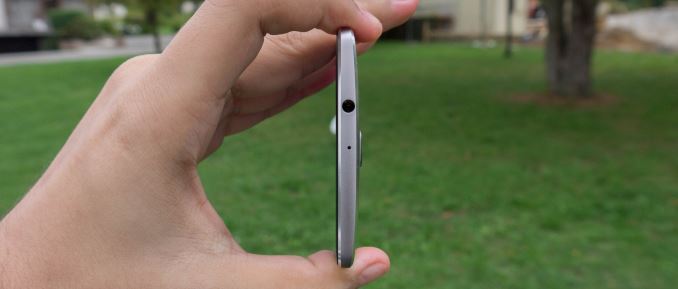
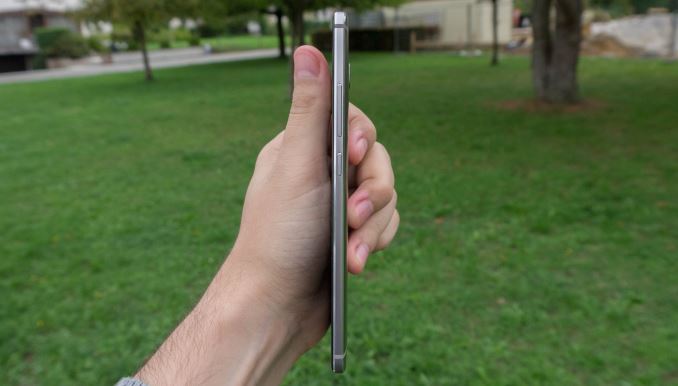
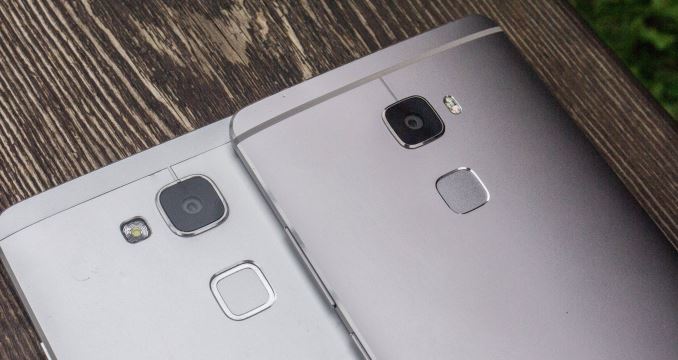


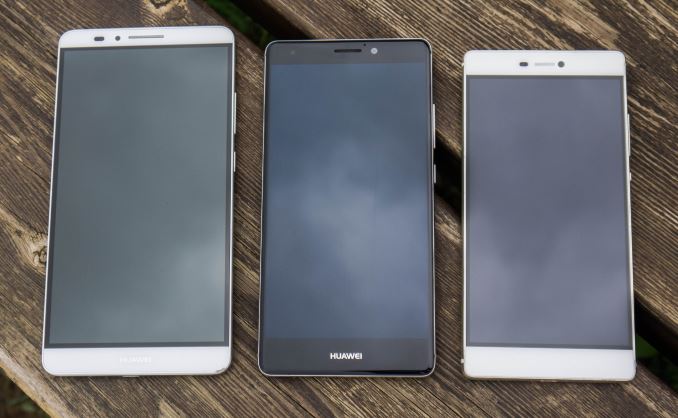



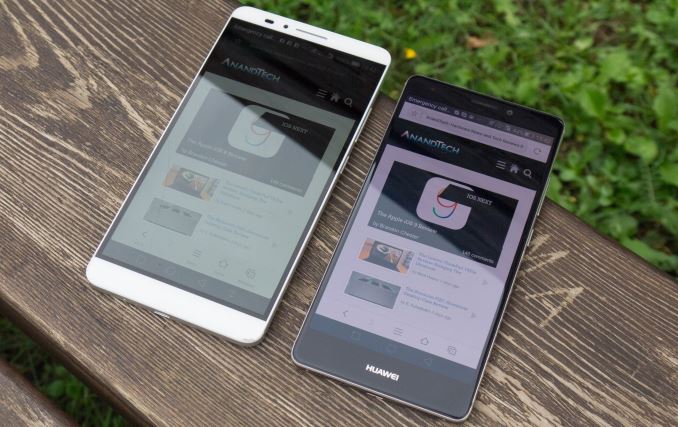








54 Comments
View All Comments
tipoo - Wednesday, December 2, 2015 - link
The 4 low power cores seem to consume more power than the high performance core cluster, they just shut off earlier. Curious.With lower core counts in use it shaves off a bit though, but I'm still not convinced big.LITTLE with the same core types is worthwhile. Radically different cores? Sure. Might have more to do with "8" being significant in China.
Exophase - Wednesday, December 2, 2015 - link
You can't say either cluster consumes more or less power than the other because they have different power/frequency curves. The power-optimized cluster may use (marginally) more power near the top of its clock speed but you can see by 1GHz it uses significantly less. I don't know precisely how the two different clusters vary but I would guess that the power optimized cluster sacrifices much voltage/frequency scaling in exchange for much lower leakage.Since the scheduler works with a gap between the "up" and "down" transition points in order to avoid hysteresis it makes sense to have the upper end of the power optimized cluster's performance range exceed the lower end of the performance optimized cluster's. Even if it uses a little more power doing so.
From a pure DVFS standpoint the power consumption curves presented are a fairly convincing argument for why this A53 + "A53e" setup is worthwhile. Either cluster on their own is pretty clearly inferior, either the A53e cluster needing 100+mW while on at its lowest frequency or the A53 cluster incapable of exceeding 1.5GHz. Perhaps a hypothetical implementation in between the two would be "good enough", but I'd argue that if you must use Cortex-A53 cores even a couple hundred extra MHz at the upper end is highly desirable for a lot of users.
Since the utility of DVFS is a foregone conclusion at this point the only real question is if the overhead in transitioning between cores is small enough to make this work as a DVFS system (we'll put aside the extra advantages and complications of a full HMP setup). A lot of people are arguing that it isn't, but I'm not really seeing hard data to support this. I personally believe people underestimate the number of loads that either have low frequency swings in performance requirements or reach a full on steady state for long periods of time. Even on mobile devices.
Andrei Frumusanu - Wednesday, December 2, 2015 - link
Yes, good analysis.Please keep in mind that we might not be seeing the full curves as the vendors simply cut them off where it doesn't make sense. The 1GHz point is extremely important as a pointer as to what the actual physical difference is. Again it's a pity that I can't access the voltages on HiSilicon SoCs otherwise this would be a much easier discussion to back up, but imagine that for the perf cluster the 1GHz spot would basically be the bottom in terms of scaling voltage down at which point race to idle takes over. The other way round for the power cluster, voltages at the top frequencies there might already have reached the high end and thus not be able to go further up in frequency, but on the other side of the curve they're able to go much lower in power.
All in all I think it still makes a lot of sense in terms of implementation.
deskjob - Wednesday, December 2, 2015 - link
Is it me or is this a blatant rip-off of the HTC One series design language?s.yu - Saturday, December 5, 2015 - link
Huawei's been copying designs from this company and that. P8 was some Sony with a little Apple and HTC, lol.fanofanand - Wednesday, December 2, 2015 - link
At the heart of the Mate S we find the HiSilicon Kirin 935. This is the same SoC that was found on the basic model Huawei P8Chart shows 930
Andrei Frumusanu - Wednesday, December 2, 2015 - link
Corrected, thanks. But in truth they're both the same piece of silicon, the 935 is just a marketing name of the higher binned SoC.fanofanand - Wednesday, December 2, 2015 - link
I just know you are a details guy. I love reading your analysis and have bought 2 phones based on your reviews. Keep up the great work and ignore the Apple/Samsung trolls :)Ethos Evoss - Wednesday, December 2, 2015 - link
HUaaaweii smartphonee got battered as usual on this site :DDDAnanadidatechno-tech .. I CANNOT WAIT for Mate 8 review what u gonna say all about it ..
I BETTING on next batter AGAIN :DDD even it has higher specs .. you will describe all as all on bottom graphs :DDD
Don't worry I do not own huawei smartphone anymore.. will see in future.. :)
Ethos Evoss - Wednesday, December 2, 2015 - link
You completelly forgot about Force Touch tho ..